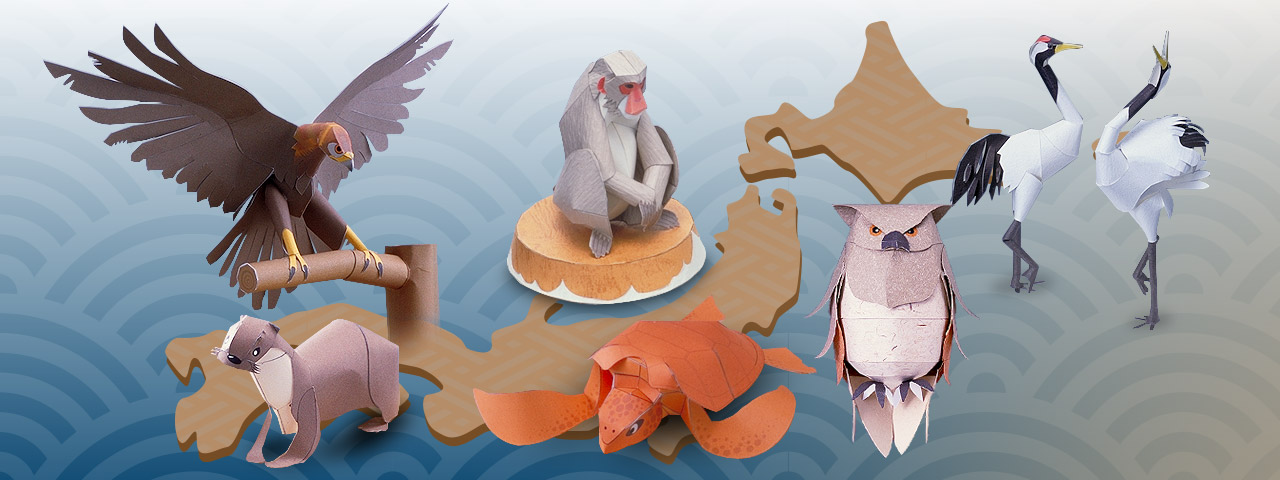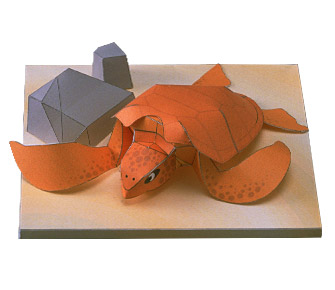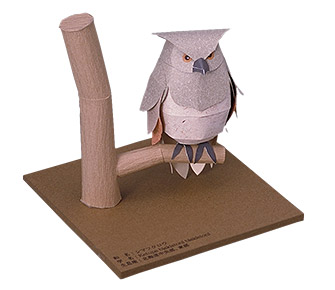Japanese Golden Eagle
Papercraft kit : The Japanese golden eagle, the Japan's largest bird of prey.

The Japanese Golden Eagle, a member of the eagle family, reaches 80 to 90 centimeters (32 to 36 inches) in length, and is characterized by its large, black wings and distinct golden wash over the back of the head. The majestic raptor, a most dominating figure in the bird kingdom, makes its home in mountainous regions in Japan. However, its number in the wild has diminished due to human environmental development projects.
The Japanese Golden Eagle is currently classified in the Red List as an "Endangered [EN]" species.
Assembly instructions for paper sculptures of the Japanese Golden Eagle, as well as photo images of completed sculptures, may be downloaded at this web site.
Download - Parts sheet & InstructionsThis data was released in November, 1999.
Japanese Golden Eagle - Animal Guide

- Japanese Golden Eagle - Accipitridae
- Aquila chrysaetos japonica
- 80 to 90 cm (32 to 36 in.) long / 200 cm + (80 in. +) wing span
- RED DATA BOOK (RDB) categories : Endangered [EN]
The Japanese Golden Eagle (Aquila chrysaetos japonica), a member of the eagle family, is a large raptor, with a wingspan reaching 200 centimeters or more (80 inches or more). A typical raptor, the Japanese Golden Eagle has piercing eyes and a sharp beak. Its body plumage is dark brown, with a distinct golden wash over the back of the head and neck, giving the species its name.
The Japanese name, Inu-washi, literally means "big eagle". The species was eventually considered to be the original source of the Japanese mythological figure, "Tengu", a long-nosed goblin. This was due probably to the use of the same kanji character for the words, Inu-washi and Tengu. In ancient times, if a child was suddenly found missing from a mountain village, the people of the village would conclude that "the child was kidnapped by Tengu." The people were probably prompted to formulate the imaginary character out of fear after seeing a giant shadow-like figure flying at high speed through the air.
The Japanese golden eagle feeds mainly on snakes, copper pheasants, and hares, but it also hunts mice, rats, and dogs. Once the eagle, riding high on the wind with its wings fully spread, finds prospective prey on the ground, it nose-dives with its wings tucked in and resolutely grabs its prey with its sharp, spiked talons. The eagle usually lays two eggs at once. The male and female keep from two to five nests in various locations and live within their nesting area throughout their whole life span.


Habitat
The Japanese Golden Eagle builds its nest on cliff ledges in mountainous country using sticks and twigs of Japanese cypress, beech, and maple trees. It inhabits the Shirakami Mountains (a World Heritage region located on the border of Aomori and Akita prefectures) as well as other mountainous areas of Hokkaido and Honshu.
Because the species requires vast space in the wild to hunt for food, recent deforestation has diminished their numbers. A very cautious creature, the eagle stops breeding freely in an artificial man-made environment. It is currently believed that approximately only three hundred birds survive. The Japanese Golden Eagle was designated as a "Natural Treasure" in May of 1965 by the Japanese government. In order to save the eagle from the danger of extinction, various wildlife preservation organizations and zoos have been making an active effort to artificially raise, breed, and protect the eagle.


(Photographed in Shirakami Mountains)
Photographed by Takeo Makino / Hakusan Nature Conservation Center / IWASAKIMURA-YAKUBA.
About RED DATA BOOK
The Red Data Book is a report compiled by the Environment Agency classifying various threatened animals in Japan and their present status. From a biological viewpoint, the Environment Agency has evaluated the extinction risk level of each individual taxon and compiled a list for the Red Data Book. However, the Book possesses no legal power to enforce regulations concerning threatened species.
The Red Data Book is broadly employed as fundamental information for advancing the preservation of threatened wild animals.
| EXTINCT | EX | A taxon considered to have become extinct in Japan. |
|---|---|---|
| EXTINCT IN THE WILD | EW | A taxon known to survive only under conservation or in captivity. |
| CRITICALLY ENDANGERED | CR | A taxon facing an extremely high risk of extinction in the wild in the immediate future. |
| ENDANGERED | EN | A taxon facing a very high risk of extinction in the wild in the near future though not critically endangered. |
| VULNERABLE | VU | A taxon facing a high risk of extinction in the wild in the medium-term future though not critically endangered or endangered. |
| NEAR THREATENED | NT | A taxon which can qualify for VULNERABLE in the future depending on its habitat conditions, although it is not facing a high risk of extinction at this present stage. |
| DATA DEFFICIENT | DD | A taxon about which there is not adequate information to make a direct, or indirect, assessment of its risk of extinction. |
| THREATENED LOCAL POPULATION | LP | A taxon facing a high risk of extinction in a certain locality among its limited specific habitats. |
From Environment Agency press materials










